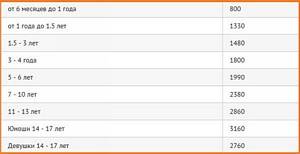Not only the fair sex, but also men want to look attractive and fit. To keep fit and feel good at the same time, it makes sense to know what the daily calorie intake per day is for a man . After all, this indicator determines how much and in what quantities you need to consume certain products. We also recommend reading our article about what calories are.
The amount of consumption of certain dishes will allow you to maintain a balanced diet. Indeed, in addition to calories, it is worth paying attention to the presence of proteins, fats and carbohydrates. Especially if a man is trying to lose weight. In addition, the daily caloric intake rate is also important for those who engage in heavy physical labor or regularly train or visit gyms. Without the required amount of kcal, you simply won’t have enough strength to do it. At the same time, with an excess of calories, body weight will gradually increase and the problem of how to lose excess weight will arise.
What determines your daily calorie intake?
This indicator depends on gender, age, activity level, metabolic health, height, genetic predisposition to obesity... For example, for the normal functioning of the female body, 15-20 percent less energy is required than the male one.
Therefore, it is advisable to compile the daily diet and the ratio of nutrients in it (BJU, vitamins, minerals, microelements), taking into account the characteristics of a particular organism. There are several options for calculating calories:
- according to the Harris-Benedict or Mifflin-San Geor formulas, very popular among nutritionists due to their increased accuracy;
- using a ready-made calculator, the algorithm of which includes one of the above formulas;
- according to average tables.
Enter data:
The basis of any of these methods is the calculation of the basal metabolic rate (BMR) of a particular person. This is the number of kilocalories that he requires for the normal functioning of all reproductive systems: digestive, respiratory, nervous, sensory, urinary, circulatory, musculoskeletal, cardiovascular... The resulting BMR figure is multiplied by additional coefficients that directly depend on the physical activity of the individual, After all, 30...90% of kilocalories are spent on everyday movement.
How many calories do you need to build muscle?
To build muscle, the amount and type of calories you consume are important. Athletes trying to build muscle need calories from protein. Protein should make up up to a third of a bodybuilder’s total diet. Nutritionists say that every athlete needs to look for his own calorie balance.
The average values are as follows: to build from 450 to 900 g of muscle, you need to increase the daily basic amount of calories by 400–700 energy units. On average, this will be around 40 (or higher) calories per kilogram.
Harris-Benedict formula
Physiologists F. G. Benedict and D. A. Harris created its original version empirically back in 1919. To do this, they studied more than 200 people of different genders, age and weight categories. In 1984, the original formula for calculating calorie intake per day was slightly modified in order to more correctly take into account a person’s age. Here's what the refined version looks like:
- women: 447.593+9.247×Weight [kg]+3.098×Height [cm]−4.33×Number of completed years;
- men: 88.362+13.397×Weight [kg]+4.799×Height [cm]−5.677×Number of complete years.
To determine the exact number of kilocalories that the body needs daily, you also need to multiply the resulting BMR value by the physical coefficient. human activity. It is this coefficient that lies the main problem with the accuracy of the results obtained, since its value can vary over a fairly wide range (from 1.2 to 1.9). This means that the final result may differ by several hundred kilocalories.
According to the Harris-Benedict method, there are five degrees of weekly activity of an individual:
- low (complete absence of any physical activity) - 1.2;
- low (light exercise every other day or two) – 1.375;
- average (more intense classes every other day) – 1.55;
- high (daily sports) – 1.725;
- maximum (intensive professional load) – 1.9.
As an example, let’s try to calculate the daily calorie intake for women using the formula developed by these scientists. Let's consider a girl, 30 years old, 1 meter 70 centimeters tall, weighing 55 kilograms, who trains in the gym every other day.
BMR = 447.593+9.247×55+3.098×170–4.33×30=1353 kcal. Multiplying the resulting figure of 1353 by 1.55 (activity coefficient) gives us the final result - 2097 kilocalories. This is her daily norm.
Calorie norms for men are calculated in the same way. For comparison, let’s take a 30-year-old young man with the following parameters: B - 70 kg, P - 180 cm, who also goes to the gym every other day. We substitute these parameters into the formula and get 1720 kcal. Multiply by the coefficient of active metabolism 1.55, the result is 2665 kcal.
Try doing the same calculations with your data.

Calorie calculators
The daily calorie intake for men, women and adolescents does not have to be calculated manually using various tables. You can always find an online calculator on the Internet. In addition, you can download special programs or applications to your computer or phone that will perform all the calculations independently.
They are easy to use: just enter the required data.
When using the services of such programs, it should be borne in mind that the indicators provided are based on average indicators (without taking into account the physical characteristics of a particular user), so they can only serve as a rough guide.
Fitness trainers can also count calories, but you shouldn't rely on this information too much. According to 2021 data, most popular fitness trainers give an error (in both directions) of up to 200 calories per day.
The surest way to get the most accurate indicators is to keep an individual food diary.
Mifflin-San Geor model
It was developed by American nutritionists at the beginning of this century (in 2005). It is considered the most accurate calculation method, since it takes into account changes in the lifestyle of modern people that have occurred over the past century. In simplified form it looks like this:
- men: BMR=10xWeight [in kilograms]+6.25xHeight [in centimeters]–5xAge [in years]+5;
- women: BMR=10xWeight [in kilograms]+6.25xheight [in centimeters]– 5xage [in years]–161.
Its modified version allows us to obtain the most accurate figure, since it takes into account the coefficient of a person’s weekly activity. The value of the coefficient varies within (1.2...1.9) and is determined in the same way as in the Harris-Benedict method described above. It is multiplied by the BMR value calculated by the formula.
To compare the two methods, let's calculate the daily caloric intake that is necessary for leading a healthy lifestyle for the same people we have already talked about. We substitute their parameters into the formula, we get: for a woman – 2015 kcal, for a man – 2604 kcal.
As can be seen from the calculations obtained, different methods give slightly different results. Which option is better to use? The choice is yours. Nutritional researchers have concluded that the Mifflin-Geor model provides the most accurate numbers for healthy people without significant differences in body weight. But for people with obesity or serious chronic diseases, it is better to consult a nutritionist.
IT IS IMPORTANT. For those who don’t want to bother with a calculator, multiplying multi-digit numbers using the formula proposed above, there is a very simple way - use a special online calculator, in which it is already built-in. This will not require much effort from you; you just need to enter your data to immediately get the finished result. Average tables are the most complex and time-consuming option. Therefore, we will not consider it in detail now.
Having received a specific figure after all these calculations, you will already know exactly how many kilocalories you need to eat in one day. This will help you correctly adjust your menu and quickly get rid of hated fat deposits. However, we recommend not to consider the calculated figure as a panacea. It is just a convenient tool, the purpose of which is to help you maintain your health and figure.
Average daily calorie intake for a woman

Women at all times have strived to have ideal forms. And these days, a sporty figure has become as integral an attribute of any girl as fashionable clothes or stylish makeup. To do this, they use any available methods - newfangled diets, expensive salon procedures, sports. The main thing is to adhere to a scientific approach, which is based on the correct selection of a diet, taking into account the optimal ratio of dietary fat and calorie counting. Proteins, carbohydrates and fats are the key elements that are responsible for providing the human body with energy and supporting all important biochemical processes in it.
Women require less calories compared to the opposite sex. Their average daily intake is 2200-2300 kcal, but it is only relevant for girls who lead a sedentary lifestyle and do not load themselves with any physical activities. This figure must be increased by 200-300 if the daily regimen includes at least a minimum amount of exercise.
There is another important point that is important to remember. After forty years, the speed of all metabolic processes slows down, so for women aged 40...59 years, daily caloric intake should be reduced to 2000-2200 (for an inactive lifestyle) or to 2200-2400 (for those involved in any sport). After 60-70 years, the indicators drop to a minimum: 1950-2050.
If your goal is to lose weight

Then you need to subtract 500 or 15-20% from the average or formula-calculated normal values (regardless of your age category, activity levels, nutrition). In this case, weight loss will occur gradually, over several months to six months. Such a relatively long period of time will allow your body not to slow down its metabolism and activate the performance of all its organs.
IT IS IMPORTANT. Nutritionists call the numbers 1000-1200 a safe lower calorie limit for women. In the absence of medical supervision, it is not recommended to reduce it below this threshold. Otherwise, you can provoke a weakened immune system, disruptions in the cardiovascular, digestive, nervous systems, or even general exhaustion of the body.
The main thing is not to create a sharp deficit of energy consumption (for example, by 30-40% at once). This method of losing weight will negatively affect your health and be accompanied by physical and emotional discomfort. And sometimes - more serious problems (menstrual irregularities, increased/decreased blood pressure, stomach diseases).
If you need to gain muscle mass

Then you must add 20% to the previously obtained figure. But at the same time, be sure to include in your daily menu foods that promote active muscle growth. That is, containing a lot of protein (this is the most important thing) and a strictly calculated amount of carbohydrates and fats.
To achieve this goal, a woman’s body should receive 1.6…2.0 grams of protein per kilogram of total weight every day. The most protein is found in the following foods:
- eggs;
- chicken, veal, beef;
- legumes;
- fish of the salmon family;
- fatty fermented milk products;
- peanut.
But it's not just protein that's important for creating new muscle. They also require the hormone testosterone, the production of which requires fats (especially Omega-3, Omega-6). At the same time, you should not be afraid of fats; the main thing is to correctly observe the proportions of fatty acids in the products you eat. The daily fat intake for women is 0.9…1.2 grams per 1 kilogram of weight. They are found in meat, full-fat milk, vegetable oil, eggs, seeds, and avocados.
There is a third component that is important for building muscle. These are carbohydrates. Without glucose released during their absorption, normal metabolism and coordinated activity of the central nervous system and cardiovascular system are impossible. To increase muscles, a woman should receive 3-4 grams of carbohydrates per day per kilogram of weight, which is on average 200-250 g. It is better to consume healthy or complex carbohydrates, since the human body spends more energy on their absorption. For example, porridge prepared from various cereals, raw/boiled vegetables, bran bread.
Norms for children and adolescents
All children are born different. Therefore, it is impossible to talk about any ideal number of energy units that a child needs for a normal life. It should be taken into account that for a growing organism this value cannot be a constant.
The recommended norms for children from one to 4 years of age range from 1200–1400 units, and for 6–12 years old these norms range from 1600 to 2200 calories.

As puberty progresses, the required caloric intake increases. Adolescents have a higher need for energy units than other age groups. For boys, both 2500 and 3000 calories per day are normal. For girls these values are lower. By the age of 17–18, the number of calories consumed approaches its maximum. In subsequent years, these data decrease by approximately 1% every 5 years.
| Years | Average daily value (cal) | |
| Boys | Girls | |
| 10 | 2200 | 1950 |
| 12 | 2400 | 2100 |
| 14 | 2650 | 2150 |
| 16 | 2850 | 2150 |
Teenagers who are interested in sports, dancing, and tourism require 500–600 more energy units than their less active peers.
Average daily calorie intake for men

If you want to more accurately calculate your indicator, you can use the formulas described above or a ready-made Internet calculator. But there are also averages that can be used to determine the amount of daily energy. The average male representative who does office work and does not go to the gym should consume 2500-2900 kcal in one day. With additional sports loads, the number should be increased by 300.
For representatives of the stronger sex, whose age is in the range of 50-60 years, it is necessary to reduce it by 200-250. But for the age group 18-40 years old - increase by 500. The lowest consumption is in people over 70 years old (about 2000-2100 kcal).
If you want to lose weight

Men, unlike the opposite sex, have an accelerated metabolism. Therefore, they tend to lose weight much faster. In order for weight indicators to go down, they need to create a calorie deficit, that is, reduce their norm by 10-20% (for the most favorable, safe option for losing weight) or by 20-25% (for accelerated weight loss in one to three months). With such an energy-moderate diet, they will spend more than they consume.
IT IS IMPORTANT. Don't cut your energy consumption too sharply. If you create a deficit of 30-40% at once, you can slow down your metabolism as much as possible. As a result, your body will save accumulated fat mass “just in case” instead of intensively losing weight, as you planned.
There are two more rules that anyone who is trying to lose weight needs to remember. First: your daily calorie intake should not fall below a figure that is equal to your weight divided by 0.45 and multiplied by 8 (weight/0.45 * 8). Second: to intensify the process of losing weight, it is better to constantly exercise and follow a diet.
If your goal is to gain muscle mass

The most important rule for increasing muscle size is to eat 15-20% more calories during meals than you burn throughout the day. And besides this, it is still necessary to balance the daily consumption of BJU taking into account your calorie intake. If your diet does not contain enough of them (in the first place, of course, proteins), neither a strict diet nor the most sophisticated exercise system under the supervision of a trainer will help.
Proper nutrition provides for the male sex the following daily amount of BJU (depending on total body weight):
- protein – 2.5...3.5 grams per kilogram of weight;
- carbohydrates – 4...5 grams per kilogram of weight;
- fat – 1…1.5 g per kilogram of weight.
Any of these elements is irreplaceable, as it plays an important role in muscle formation. But it is important to know that, for example, saturated fats (pork, sausages, confectionery) are not beneficial, so it is better to replace them with unsaturated fats containing Omega-3, 6 acids (olive/sunflower oil, sea fish, dairy products).
IMPORTANT POINT. Don't expect to transform your extra pounds into muscle. Before you gain muscle volume, you will have to get rid of excess fat. To do this, adjust your menu and daily routine, and there is no need to cancel your workouts.
What you need to know about calories and why they are needed?
Food is a source of energy that allows us to live and perform everyday tasks. A calorie is a unit of measurement of the amount of energy the body receives from food.
It should be noted that this term, applied to the energy content of plates, is more appropriately replaced by kilocalorie (1 kcal is 1000 cal).
For the normal existence of the body, energy balance must be maintained, that is, a reasonable ratio between the energy received and consumed.

The amount of energy consumed is composed of two indicators:
- energy that maintains the vitality of the body at rest (it allows breathing, regulates temperature, ensures the functioning of the heart, brain, enables the digestive process and many other important functions);
- energy required to perform different types of activities (work, sports, games).
To maintain optimal balance, you should take in enough calories each day to cover your energy expenditure. With a positive balance (when fewer calories are expended than consumed), there is a threat of weight gain due to the accumulation of excess.
With a negative balance (when less is produced than is spent on the body’s needs), the body goes into “emergency” mode and begins to use the resources accumulated earlier.
Tracking calories helps you maintain an optimal weight, stay fit, and make smart food choices.
The daily number of calories required by a person is strictly individual and depends on many factors:
- physical data;
- gender;
- activity;
- mental and psychological state;
- genetic characteristics.
But the researchers still came up with an average. It is believed that an adult needs about 35 calories per kilogram of weight per day. Women need fewer calories than men (females range from 1,600 to 2,350 calories per day, and males require 2,500 to 3,000).
How to create a daily menu
If you accurately calculate your daily caloric intake and strictly adhere to it for a long time (for example, several years), you can achieve not only stabilization or weight loss. You will easily cope with physical or mental stress, and you will not be as susceptible to colds, infections, and even attacks of chronic diseases. A rationally selected diet means good health, a thriving appearance, and a great mood.
But several factors should be taken into account: the calorie content of the food you eat, the method of preparing it, as well as the variety of foods used. It is very important to learn more about the composition and properties of the products you buy, their effect on a healthy body and various chronic diseases. The knowledge gained will help you introduce potentially important elements into your daily menu, correctly combine, prepare and consume the right amount of foods.
You should know that all food products are divided into:
- low calorie content (vegetables, greens);
- low calorie content (milk, cottage cheese, turkey, rabbit, seafood);
- medium calorie content (various cereals, whole grain bread);
- high-calorie (cheeses, white bread, sweets, fatty meats).

But the calorie content of the finished dish also depends on the method of its preparation (steamed or boiled dishes retain the maximum of nutrients), the compatibility of various products (proteins with slow carbohydrates are much better compatible than fats with simple carbohydrates), production technology (cereal flakes are much more caloric the cereals themselves). It is important to draw up your average daily diet based on all the knowledge you have acquired - then you are guaranteed a good metabolism and the absence of metabolic disorders of various origins.
Advice from doctors and nutritionists
Daily calorie intake for men and women - useful information. However, controlling the calories you take in and burn out is actually quite difficult. Any data obtained will be very approximate. There are many reasons.
Here are just a few of them:
- For example, it is impossible to say exactly how many calories a particular person actually needs for basal metabolism. This calculation can be done by resorting to indirect calorimetry. However, even here we cannot vouch for accuracy.
- The energy value data indicated on product packaging is also not a standard of accuracy: the error can be up to 20%.
- Databases do not provide reliable information on calories: two identical (200 g) beef steaks can differ by up to 200 kcal.
- Not all calories consumed are used by the body (for example, only 68% from almonds).
- Cooking methods change the calorie content of the product: boiled potatoes have about 80 calories (kcal), fried potatoes - from 200 to 250.
- The degree of digestibility of food products also depends on the gastrointestinal flora.
Therefore, nutritionists advise only focusing on generally accepted calorie standards and listening more to the needs of your own body.
To make it easier to give up extra calories and make your diet more rational, you can use a few simple tips:
- Place food only on small plates that cannot accommodate a large portion.
- Half the plate should be vegetable salads, ¼ should be protein foods (lean meat, eggs, fish, dairy products), ¼ should be high-quality carbohydrates (brown rice, quinoa, whole grain bread).
- Sauces and gravies should not be poured directly from the bottle (it is so difficult to control the amount of product eaten).
- There should always be food prepared in advance in order to muffle the feeling of hunger in time.
- You should include more unprocessed foods in your diet, especially those high in fiber (raw vegetables, fruits).
- Be sure to keep detailed notes in your food diary.
All nutritionists say that focusing entirely on daily calorie intake and ignoring the quality side of food is a big mistake. In addition, you should listen more to the needs of the body (especially the feeling of hunger).
Therefore, it is more useful for men and women who care about their figure to rely on their body’s signals more often than to completely trust some random number.
Author: Irina Zhuravka
Article design: Vladimir the Great
Basic principles of healthy eating
- Constantly adhere to the chosen optimal diet.
- Maintain a daily eating schedule.
- Make your menu as varied as possible.
- Compare your caloric intake with the energy you expend during the day.
- Eat fruits, vegetables, dietary supplements, vitamins and minerals in the correct quantities every day.
- Try to eat more dishes that are steamed or boiled, stewed, or baked. Limit fried foods.
- Eat little salt (less than 5 grams per day) and sugar (up to 9% of your daily diet).
- Eat carbohydrates before lunch and leave proteins for the evening.
- Eat small meals several times throughout the day.
- Have dinner no later than three hours before going to bed.
- Eat slowly, chewing food thoroughly.
- Drink about two liters of still water per day.
- Forget forever about street food, sausages, sweets, chips, sweet water, buns, etc.
As for the 5th point, your complete menu must necessarily contain fats (22%), proteins (15%), carbohydrates (55%). Then your body will receive the necessary substances in sufficient quantities necessary for the normal functioning of each of its systems.
Try to consume exactly the number of calories necessary to achieve your goal (keeping your weight constant, losing extra pounds, or building muscle). I wish you success!
Consequences of incorrect calculation of BZHU
Diet compilers most often neglect calculating BJU and take into account only the number of calories. As a result, the balance of substances in the human body is disrupted, which leads to:
- Constant hunger. A person has just eaten and is already dreaming about the next meal. This clearly indicates a lack of fats and carbohydrates.
- Slow weight loss. The body receives too few nutrients, so it adapts to save resources, so that fat is burned slowly.
- Constant volume. Weight decreases due to the removal of fluid from the body and a reduction in muscle mass. But the fat layers remain in place, so there are no visual changes.
- Disturbances in the functioning of hormones. This leads to mood swings, decreased performance, and sore skin, hair and nails.
- Health problems. Nausea, dizziness, tinnitus and even fainting - all this signals an unbalanced diet.
Thus, calculating BJU is an important procedure not only for losing weight or gaining muscle mass, but also for maintaining good physical shape and improving the health of the body. Nutrition in accordance with the calculations provides all the substances necessary for the body, which entails a lot of positive consequences.










